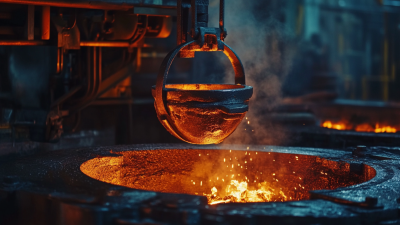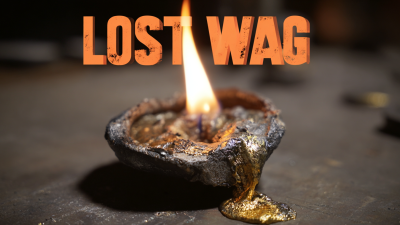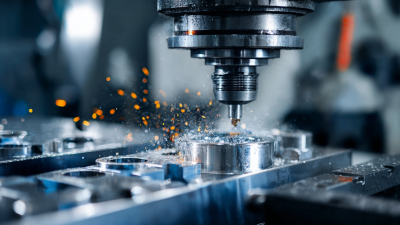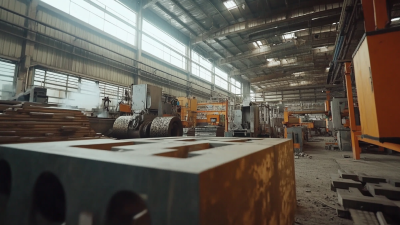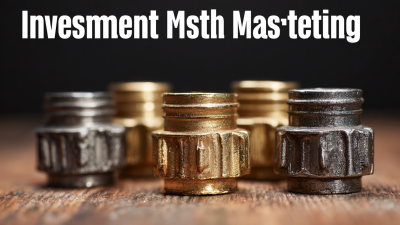 +86 180 0293 5268
+86 180 0293 5268






 In today's competitive manufacturing landscape, optimizing production processes is essential for achieving greater efficiency and cost-effectiveness. One innovative approach that has gained significant traction is the use of Stainless Investment Casting techniques. This method not only enhances the precision and quality of the produced parts but also allows for the creation of complex shapes that traditional casting methods struggle to achieve.
By incorporating Stainless Investment Casting into the production workflow, manufacturers can significantly reduce material waste, minimize post-processing time, and improve overall product performance. As industries continue to seek reliable and sustainable solutions, understanding the intricacies of Stainless Investment Casting becomes imperative for those looking to stay ahead of the curve while ensuring high standards in their production processes.
In today's competitive manufacturing landscape, optimizing production processes is essential for achieving greater efficiency and cost-effectiveness. One innovative approach that has gained significant traction is the use of Stainless Investment Casting techniques. This method not only enhances the precision and quality of the produced parts but also allows for the creation of complex shapes that traditional casting methods struggle to achieve.
By incorporating Stainless Investment Casting into the production workflow, manufacturers can significantly reduce material waste, minimize post-processing time, and improve overall product performance. As industries continue to seek reliable and sustainable solutions, understanding the intricacies of Stainless Investment Casting becomes imperative for those looking to stay ahead of the curve while ensuring high standards in their production processes.
Stainless investment casting is a sophisticated manufacturing process that offers numerous advantages, making it an essential technique in various industries. One of the key benefits of this method is its ability to produce highly complex shapes with exceptional precision. This capability allows manufacturers to create intricate components that may be challenging or impossible to achieve with traditional manufacturing techniques. Furthermore, the smooth surface finish of stainless investment castings reduces the need for extensive machining, leading to lower production costs and shorter lead times.
Industries such as automotive, aerospace, and medical equipment heavily rely on stainless investment casting due to its remarkable strength and corrosion resistance. As these sectors continue to expand, the demand for high-quality, durable parts increases, positioning stainless investment casting as a preferred choice for component production. Additionally, the continuous innovations in materials and processes significantly enhance the efficiency and effectiveness of stainless investment casting techniques, further solidifying their role in optimizing production processes across various applications.
Choosing the right materials is crucial in optimizing the stainless investment casting process. The selection of stainless steel grades significantly impacts the final product's strength, corrosion resistance, and manufacturability. Commonly used grades include 304, known for its excellent corrosion resistance and ease of fabrication, and 316, which provides enhanced strength and resistance to pitting in saltwater environments. Depending on the application, it is essential to consider the specific requirements such as operating temperature and exposure to harsh chemicals when selecting the appropriate material.
Additionally, the choice of alloying elements plays a vital role in the performance of the cast product. Elements like molybdenum and nickel can improve the overall quality and durability of the casting. Furthermore, understanding the melting and pouring characteristics of each material can aid in achieving a more effective casting process, minimizing defects and enhancing precision. By carefully evaluating these factors, manufacturers can ensure that their stainless investment casting techniques yield optimal results, leading to cost-effective and high-quality end products.
| Material Type | Melting Point (°C) | Tensile Strength (MPa) | Corrosion Resistance | Applications |
|---|---|---|---|---|
| Stainless Steel 304 | 1400 | 520 | Good | Food Processing, Kitchen Equipment |
| Stainless Steel 316 | 1400 | 580 | Excellent | Marine Applications, Chemical Processing |
| Stainless Steel 410 | 1480 | 550 | Fair | Cutlery, Fasteners |
| Stainless Steel 420 | 1450 | 600 | Fair | Medical Instruments, Tools |
| Stainless Steel 430 | 1400 | 480 | Good | Automotive Trim, Appliances |
In the realm of investment casting, optimizing production processes is essential for improving efficiency and reducing costs. One effective approach is to integrate advanced digital manufacturing technologies, which can dramatically enhance productivity. By utilizing these technologies, manufacturers can streamline their workflows, reduce lead times, and improve overall output quality.
Tips for Streamlining Your Production:
1. **Leverage Automation**: Implementing robotics in your casting processes can minimize manual labor, reduce human error, and ensure precise repetition of tasks, thus significantly boosting productivity.
2. **Adopt Digital Tools**: Use software for design and simulation to foresee potential challenges in the casting process. This proactive approach can help in identifying issues early and adjusting production methods accordingly.
By focusing on these strategies, manufacturers can not only optimize their processes but also maintain a competitive edge in the ever-evolving market. The synergy between modern technology and traditional methods of investment casting can lead to a more efficient, agile production environment, ultimately driving success in a fast-paced industry.

In the realm of stainless investment casting, quality control measures are paramount to ensure the precision and durability of the final products. Unlike traditional casting methods, stainless investment casting offers intricate designs and superior dimensional accuracy, which is crucial for industries that demand high-performance components.
To achieve this level of quality, manufacturers implement rigorous inspection processes throughout the production cycle. Techniques such as non-destructive testing and metallurgical analysis are utilized to detect any potential flaws at an early stage, thus guaranteeing the integrity of the castings.
Additionally, maintaining strict adherence to industry standards and using advanced technology can significantly enhance the quality of stainless investment castings. The incorporation of automated systems for monitoring parameters such as temperature and pressure during the casting process ensures consistency. These measures not only help in achieving optimal product quality but also reduce waste and production time. In environments where large castings are produced, such as those composed of spheroidal graphite cast iron, the complexity of the process necessitates a dedicated approach to quality control. By focusing on these practices, manufacturers can optimize their production processes while delivering components that meet the stringent requirements of their clients.
The stainless investment casting industry is experiencing significant growth propelled by technological innovations and sustainability goals. As manufacturers strive to meet evolving market demands, the emphasis on greener manufacturing processes is more pronounced than ever. According to recent market analysis, the chromium ore market is projected to grow from $1.063 billion in 2025 to $1.864 billion by 2033, showcasing a robust compound annual growth rate of 7.27%. This growth trajectory highlights the increasing integration of advanced technologies such as automation and AI in production processes, which not only enhance efficiency but also minimize environmental impact.

To keep pace with future trends, companies should embrace sustainable practices in their operations. This includes investing in energy-efficient machinery and adopting eco-friendly materials. Additionally, continuous innovation is key; organizations must stay ahead by researching and implementing cutting-edge techniques. A crucial tip for manufacturers is to conduct regular assessments of their production methods to identify areas for improvement and ensure they align with sustainability benchmarks.
Furthermore, collaboration between industry stakeholders can drive innovation forward. By sharing best practices and resources, companies can collectively work towards a more sustainable and technologically advanced future in stainless investment casting. Creating partnerships and networks can also facilitate knowledge transfer and accelerate the adoption of environmentally responsible practices across the industry.
